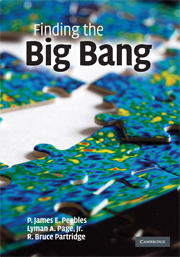Appendix
Published online by Cambridge University Press: 05 July 2015
Summary
We want to convey an impression of the broad effort that went into the measurements of the CMBR without obscuring the story with details. To that end we present separately, in this Appendix, tabulations of the experiments that figure in the panoramic illustrations of the progress of the measurements in the figures in Chapter 5. We present first a tabulation of observations of the interstellar CN absorption lines that gave important early measures of the CMBR energy spectrum. The next, longer, tabulation is of the experiments that explored the energy spectrum of the CMBR. The progress on this front is illustrated in Figures 5.2–5.4. The third and still longer tabulation shows the experiments in the enormous effort to map out the intrinsic anisotropy of the CMBR, in the developments illustrated in Figures 5.9–5.18.
Table A.1 lists the progress in measurements of the CMBR energy spectrum at the two energy level separations in the CN molecule that happen to be conveniently located for this purpose. The general method of observing the excitation of interstellar CN and interpreting the excitation in terms of the CMBR spectrum is discussed in Chapter 3 (commencing on page 42). The essays in Chapter 4 (starting on page 74) recall what happened when this interpretation was first generally realized. The observations yield measures of the CMBR spectrum at the two frequencies indicated in the table and plotted as open boxes in Figures 5.2 to 5.4. It was very important to early studies of the CMBR that the CN observation at 113 GHz combined with the measurements at lower frequencies, which could be made from the ground, showed that the CMBR has a Rayleigh–Jeans power-law spectrum with the downward departure from the power law at 113 GHz to be expected for a thermal spectrum as it heads to its peak.
- Type
- Chapter
- Information
- Finding the Big Bang , pp. 478 - 509Publisher: Cambridge University PressPrint publication year: 2009



